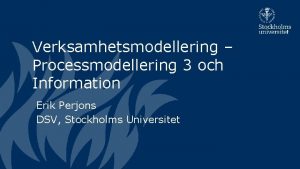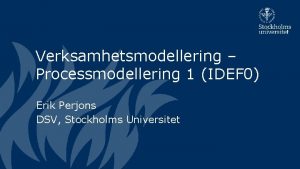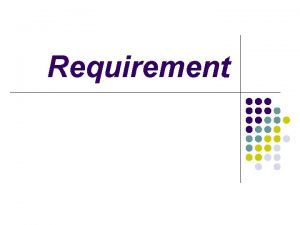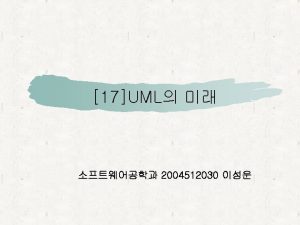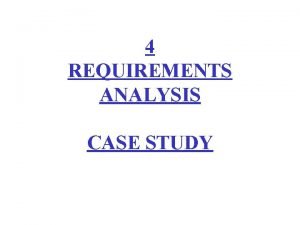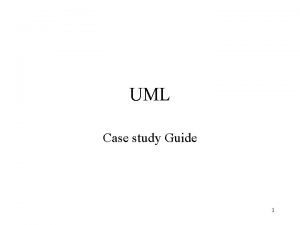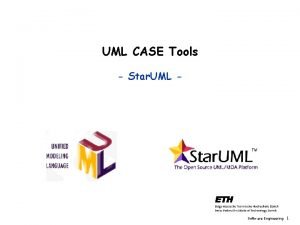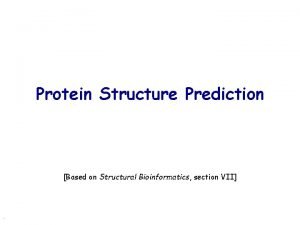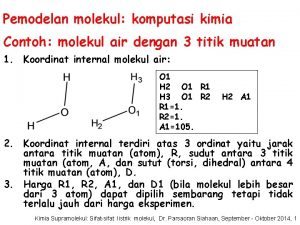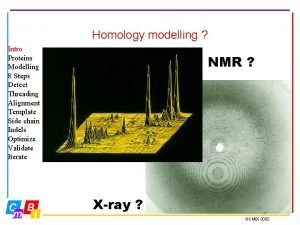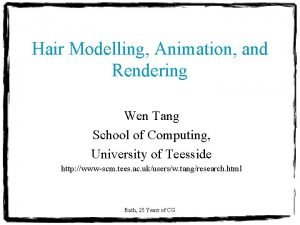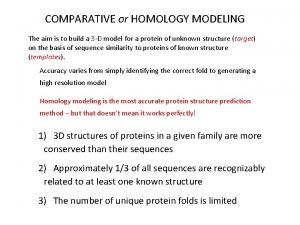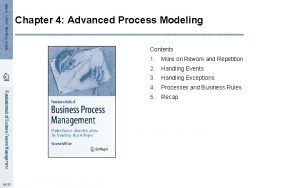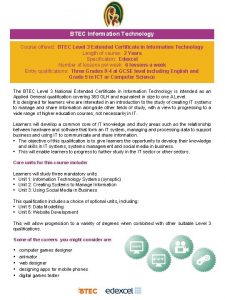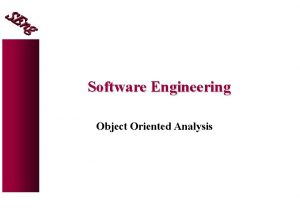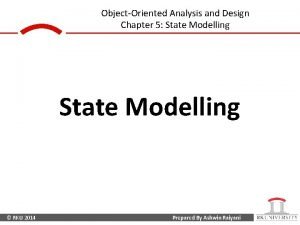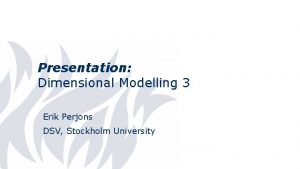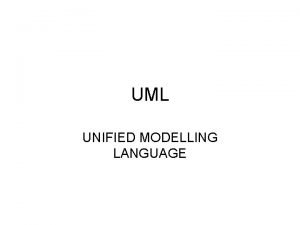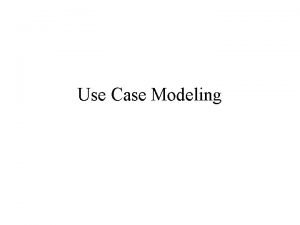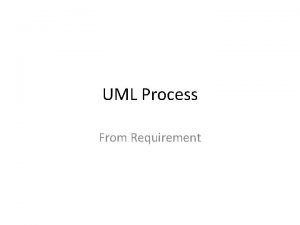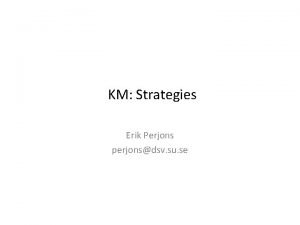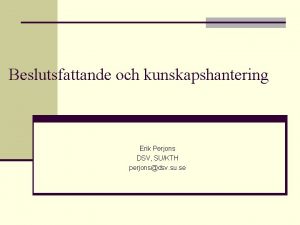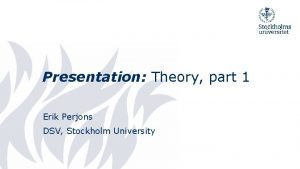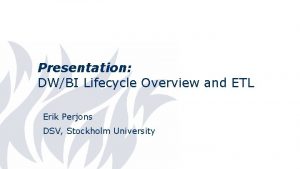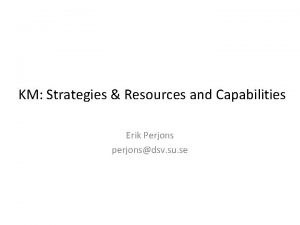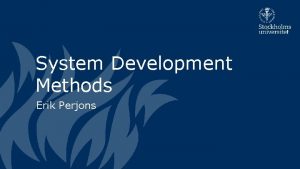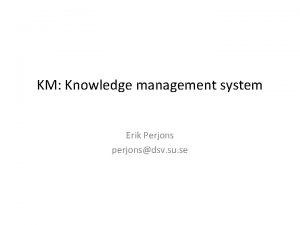Requirement Modelling with UML Use Case Erik Perjons


































- Slides: 34

Requirement Modelling with UML Use Case Erik Perjons

Questions to answer ● What is requirement engineering? ● Why is requirement engineering important? ● How can you use models to support requirement engineering?

Requirements and Models 3

Real World and Models Business process model of business activities (in UML Activity diagram) Domain model of business concepts (in UML Class diagram) Human interaction with software systam (in UML Use cases) Interaction between software objekts (in UML Sequence diagram) System model of software objects (in UML Class diagram) The real world Graphical models/diagram 4

Requirement Engineering (in Real World) Business process model of business activities (in UML Activity diagram) Domain model of business concepts (in UML Class diagram) Human interaction with software systam (in UML Use cases) Interaction between software objekts (in UML Sequence diagram) System model of software objects (in UML Class diagram) The real world Graphical models/diagram 5

Requirement Engineering Models Business process model of business activities (in UML Activity diagram) Domain model of business concepts (in UML Class diagram) Human interaction with software systam (in UML Use cases) Interaction between software objekts (in UML Sequence diagram) System model of software objects (in UML Class diagram) The real world Graphical models/diagram 6

Requirement Engineering (in the Real World) 7

Requirement Engineering • Requirement Engineering - is the process of gathering, defining, organizing, prioritizing, documenting, quality assuring and maintaining requirements

Requirement • Requirement - is a desirable property/feature/attribute/quality/capacity of a system

Functional and Non-Functional Requirements • Requirements can be categorized into functional and non-functional requirements

Functional Requirements • A functional requirement – is a function that a system should (or must/could) perform • A functional requirement is performed at the active request of a user, that is, the user actively performs an action to trigger a function, such as, write a text, select an option and/or click on a button • A functional requirement describes ”what” a system should do

Functional Requirements • Examples of functional requirements: • The system should - register an order • The system should - register a new customer • The system should - find a customer (when searching after a registered customer in the system)

Non-functional Requirement • A non-functional requirement – is a requirement of how a system should perform the functions of the system • A non-functional requirement describes how a system will work for users regardless of users' active requests during system usage • A non-functional requirement impacts the system performance, reliability, usability, security, platform constraints, etc

Non-functional Requirement • Examples of non-functional requirements: • The system must be able - to handle 100 orders in parallel • The system must be able - to integrate with systems in a Microsoft platform

Requirement Specification • A requirement specification - is a document specifying the requirements of a system.

Requirement Specification • The core of the requirement specification is the description of functional and non-functional requirements • Usually the requirement specification also describe the context of the requirements, for example, which business problems or business processes should be supported by the system

Requirement Specification and Models • The requirement specification can consist of only text, only models or both text and models: • Functional requirements - can be listed in form of text or as a combination of diagram and text (e. g. UML Use Case Diagram and Use Case Description) • Non-functional requirements - are often described in text • The context of the requitements - can be be described in form of text and/or models, e. g. business process models

Techniques for eliciting requirements ● Use case modeling – is a technique used to describe a system by describing 1) which functions the system exists of (presented in the form of a user diagram) , 2) which user roles can use these functions (presented in the form of a user diagram), and 3) how users and systems interact with each other (presented in the form of use case descriptions) ● User stories – is a technique that describe how the user is interacting with the system presented as a story (often in text, but could also be as picture (that is, a cartoon like description). User stories is a less formalized technique compared to use case modelling

Techniques for eliciting requirements ● Personas – is a technique for creating fictional persons / roles of users. These roles are then used for eliciting requirements. Personas is a technique used when the system is planned to be used by a broad and perhaps unknown group of users ● Workshop – is a technique where a group of people meet to brainstorm ideas and demands on an upcoming system

Techniques for eliciting requirements ● Prototype – is a technique used to identify an early form or model of the final system in order to visualize the system. The prototype can be used as a basis for identifying requirements for the final system

Tecnique for prioritize among requirements ● Mo. SCo. W - is an abbreviation for Must, Should, Could and Will not and is the name of a scale, where each requirement is valued by annotating it with one of these terms. The terms have the following meanings: – Must - this requirement must be met in order for the project to be successful – Should - this requirement should be met but is not necessary for the project to be considered successful. – Could - can be omitted, has no impact on the project overall result – Will not - These requirements should not be realized in this project, but in the future these may become relevant

Why Requirement Engineering? ● The major reason for failure in system development is shortcoming in requirement engineering, such as: – no requirements have been gathered at all – not all users (or other stakeholders) have been involved in the requirement gathering – users do not know what they want before they use the system in actual business process instances – the requirements are vaguely stated

Why Requirement Engineering? ● The requirements are central in the development of a system and are often the things that drive the development process

UML Use Case 24

UML Use Case Diagram Registrer for course Register for exam

UML Use Case Diagram Use Case Actor Registrer for course Register for exam Association

Use Case Description • Use case description describe the interaction Use case: Registrer for course Actor: Goal: between a user and the system • The look of the use case description is not specified in UML Main scenario: Student shall be registered for the course 1) Student wants to see available courses 2) System presents the cources 3) Student chooses a course 4) Systemet confirms registration of the chosen course

Use Case Model • Use case model – consists of Use case diagram and Use case descriptions

Guidelines for the Use Case Model • Guideline: Create one Use case description for each use case in the Use case diagram • Guideline: Use the same name of the use case in the descrption as in the use case diagram

More about Use Case Description • Guideline: The main scenario shall be divided into a set of steps, which each need to: • start with who is carrying out the step (the actor or the system) • be simple and precise statements of what are communicated between the actor and the system Use case: Registrer for course Actor: Goal: Main scenario: Student shall be registered for the course 1) Student wants to see available courses 2) System presents the cources 3) Student chooses a course 4) Systemet confirms registration of the chosen course

Managing CRUD functions Create Course Read Course Info Update Course Info Delete Course CRUD (Create, Read, Update, Delete) – four basic functions can be summarized in a Manage Use Case Manage Course Info Note! Not so good if you want to write use case description – they will be hard to write

Questions to answer ● What is requirement engineering? ● Why is requirement engineering important? ● How can you use models to support requirement engineering?

Exercise: Domain Description Zoo International is a company with eight zoos in different European cities. Zoo International has specified an introduction process that all zoos should follow. In order to support the introduction process, Zoo International aims to introduce an information system (IS) supporting the process. As a first step, requirements on the IS have been gathered from different stakeholders. Three of the requirements are as follows: • When an animal arrive at a zoo (which is part of Zoo International) the animal needs to be registered in the IS by one of the zoo adminstrators. The following information must then be registered in the information system by the administator: date of registration, name of the animal, spieces, gender, year of birth • For each animal arriving at the zoo, one of the zoo veterinarian needs to document information in the IS about the medical status of the animal after carrying out a medical investigation • For each animal arriving at the zoo, one of the animal keepers needs to document the result of the meeting between the arrived animal and its ”cage colleagues”

Exercise: Your Task ● Describe the functional requirements of the information system using UML Use Case Diagram, and make Use Case Descriptions for all the use cases
 Vattenfallsprincipen
Vattenfallsprincipen Erik perjons
Erik perjons Flödesenhet synonym
Flödesenhet synonym Konceptuell synonym
Konceptuell synonym Processmodellering
Processmodellering Erik perjons
Erik perjons Contoh requirement
Contoh requirement Uml model visio
Uml model visio Best worst and average case
Best worst and average case Uml2.0
Uml2.0 Diagram studied in requirement analysis
Diagram studied in requirement analysis Notasi uml
Notasi uml Uml case tools
Uml case tools What is technological modelling
What is technological modelling Energy based model
Energy based model Jmt java
Jmt java Molecular modelling laboratory
Molecular modelling laboratory Modelling madness what's new
Modelling madness what's new Models of interaction in hci
Models of interaction in hci Private equity case study presentation
Private equity case study presentation Define geometric modelling
Define geometric modelling Homology modelling steps
Homology modelling steps Hair modelling
Hair modelling Objectives of edlc
Objectives of edlc Homology modelling steps
Homology modelling steps Advanced process modelling
Advanced process modelling Mathematical modeling of mechanical systems
Mathematical modeling of mechanical systems Flight level
Flight level Unit 5 data modelling assignment 2
Unit 5 data modelling assignment 2 Structured analysis tools
Structured analysis tools Algorithmic cost modelling
Algorithmic cost modelling Class responsibility collaborator modelling
Class responsibility collaborator modelling State modelling
State modelling Sequence diagram penarikan uang di atm
Sequence diagram penarikan uang di atm Multi jet modelling
Multi jet modelling



